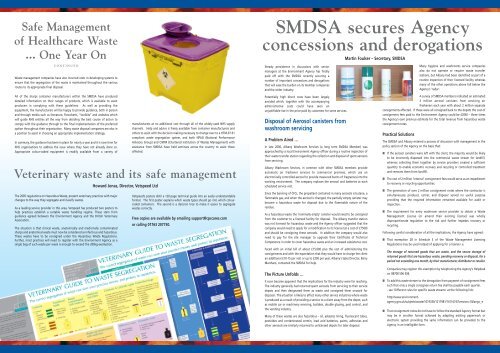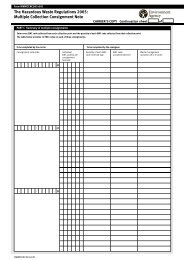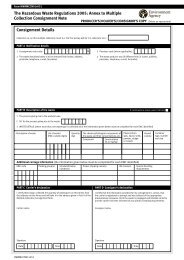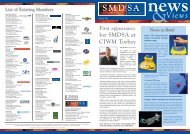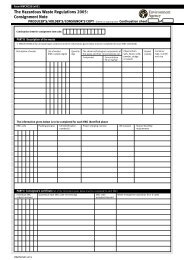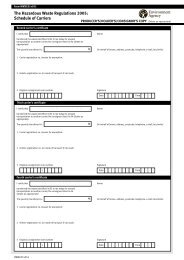&Views
Views - SMDSA
Views - SMDSA
- No tags were found...
Create successful ePaper yourself
Turn your PDF publications into a flip-book with our unique Google optimized e-Paper software.
Safe Management<br />
of Healthcare Waste<br />
... One Year On<br />
SMDSA secures Agency<br />
concessions and derogations<br />
Martin Foulser – Secretary, SMDSA<br />
CONTINUED<br />
Waste management companies have also incurred costs in developing systems to<br />
ensure that the segregation of the waste is maintained throughout the various<br />
routes to its appropriate final disposal.<br />
All of the sharps container manufacturers within the SMDSA have produced<br />
detailed information on their ranges of products, which is available to assist<br />
producers in complying with these guidelines. As well as providing the<br />
equipment, the manufacturers will be happy to provide guidance, both in person<br />
and through media such as literature, flowcharts, “toolkits” and websites which<br />
will guide NHS entities all the way from deciding the best course of action to<br />
comply with the guidance through to the final implementation of the preferred<br />
option throughout their organisation. Many waste disposal companies are also in<br />
a position to assist in choosing an appropriate implementation strategy.<br />
In summary, the guidance has been in place for nearly a year and it is now time for<br />
NHS organisations to address the issue where they have not already done so.<br />
Appropriate colour-coded equipment is readily available from a variety of<br />
Veterinary waste and its safe management<br />
The 2005 regulations on Hazardous Waste, present veterinary practices with major<br />
changes to the way they segregate and classify wastes.<br />
As a leading service provider in this area, Vetspeed has produced two posters to<br />
help practices establish a suitable waste handling regime. These stem from<br />
guidance agreed between the Environment Agency and the British Veterinary<br />
Association.<br />
The situation is that clinical waste, anatomically and medicinally contaminated<br />
sharps and anatomical waste must now be considered as infectious and hazardous.<br />
These wastes have to be consigned under the Hazardous Waste Regulations.<br />
Further, most practices will need to register with the Environment Agency as a<br />
single bag of such waste per week is enough to exceed the 200kg exemption.<br />
Howard Jonas, Director, Vetspeed Ltd<br />
manufacturers at no additional cost through all of the widely-used NHS supply<br />
channels. Help and advice is freely available from container manufacturers and<br />
others to assist with the decision making necessary to change over to a HTM-07-01<br />
compliant waste segregation system, and both NPAG (National Performance<br />
Advisory Group) and CIWM (Chartered Institution of Wastes Management) with<br />
assistance from SMDSA have held seminars across the country to assist those<br />
affected.<br />
Vetspeed’s posters distil a 120 page technical guide into an easily understandable<br />
format. The first poster explains which waste types should go into which colourcoded<br />
containers. The second is a decision tree to make it easier to segregate<br />
wastes correctly.<br />
Free copies are available by emailing support@cpccares.com<br />
or calling 01763 207750.<br />
Steady persistence in discussions with senior<br />
managers at the Environment Agency has finally<br />
paid off with the SMDSA recently securing a<br />
number of important concessions and derogations<br />
that will ease the burden on its member companies<br />
and the wider industry.<br />
Potentially high direct costs have been largely<br />
avoided which, together with the accompanying<br />
administrative costs could have seen an<br />
unjustifiable rise in the price paid by customers for some services.<br />
Disposal of Aerosol canisters from<br />
washroom servicing<br />
A Problem Aired …<br />
In late 2006, Albany Washroom Services (a long term SMDSA Member) was<br />
approached by a local Environment Agency officer during a routine inspection of<br />
their waste transfer station regarding the collection and disposal of spent aerosols<br />
from servicing.<br />
Albany Washroom Services, in common with other SMDSA members provide<br />
automatic air freshener services to commercial premises, which use an<br />
electronically controlled aerosol to provide measured bursts of fragrances into the<br />
working environment. The company replaces the aerosol and batteries at each<br />
scheduled service visit.<br />
Since the banning of CFCs, the propellant contained in many aerosols is butane, a<br />
flammable gas, and when the aerosol is changed, the partially empty canister may<br />
become a hazardous waste for disposal due to the flammable nature of the<br />
residue.<br />
As a hazardous waste the ‘nominally empty’ canister would need to be consigned<br />
from the customer to a licensed facility for disposal. The Albany transfer station<br />
was not licensed for hazardous waste and the Agency officer suggested that the<br />
company would need to apply for a modification to its licence (at a cost of £7500)<br />
and should be consigning these aerosols. In addition the company would also<br />
need to pay for the site manager to upgrade their Certificate of Technical<br />
Competence in order to cover hazardous waste and an increased subsistence cost.<br />
Faced with an initial bill of about £15,000 plus the cost of administering the<br />
consignments and with the expectation that they would have to charge the client<br />
an additional £10-15 per visit or up to £200 per year, Albany’s Sales Director, Barry<br />
Marsham, contacted the SMDSA for help.<br />
The Picture Unfolds …<br />
It soon became apparent that the implications for the industry were far reaching.<br />
The industry generally had returned spent aerosols from servicing to their service<br />
depots and then designated them as waste and consigned them onward for<br />
disposal. The situation is likely to affect many other service industries where waste<br />
is produced as a result of providing a service to a client away from the depot, such<br />
as mobile car or machinery servicing, builders, double glazing, pest control, and<br />
the vending industry.<br />
Many of these wastes are also hazardous – oil, asbestos lining, fluorescent tubes,<br />
pesticides and contaminated vermin, lead acid batteries, paints, adhesives and<br />
other aerosols are similarly returned to unlicensed depots for later disposal.<br />
Many hygiene and washrooms service companies<br />
also do not operate or require waste transfer<br />
stations, but Albany had been identified as part of a<br />
routine inspection of their licensed facility whereas<br />
many of the other operations above fall below the<br />
Agency’s ‘radar’.<br />
A survey of SMDSA members indicated an estimated<br />
3 million aerosol canisters from servicing air<br />
fresheners each year with about 2 million separate<br />
consignments effected. If these were all consigned back to the depots the cost of<br />
consignment fees paid to the Environment Agency could be £20M – three times<br />
the Agency’s own previous estimate for the total revenue from hazardous waste<br />
consignment notes.<br />
Practical Solutions<br />
The SMDSA and Albany entered a process of discussion with management in the<br />
policy section of the Agency on the basis that:<br />
■<br />
■<br />
■<br />
■<br />
If the aerosol canisters were left with the client, the majority would be likely<br />
to be incorrectly dispersed into the commercial waste stream for landfill,<br />
whereas collecting them together by service providers created a sufficient<br />
quantity to enable economic recovery and recycling or controlled treatment<br />
and removes them from landfill.<br />
The cost of 2 million ‘internal’ consignment fees would serve as an impediment<br />
to recovery or recycling opportunities.<br />
The generation of over 2 million consignment notes where the contractor is<br />
simultaneously producer, carrier, and disposer served no useful purpose<br />
providing that the required information remained available for audit or<br />
inspection.<br />
The requirement for every washroom service provider to obtain a Waste<br />
Management License (or amend their existing license) was wholly<br />
disproportionate regulation to the risk and further impedes recovery or<br />
recycling.<br />
Following careful consideration of all the implications, the Agency have agreed:<br />
■<br />
■<br />
■<br />
That exemption 28 in Schedule 3 of the Waste Management Licensing<br />
Regulations may be used instead of applying for a license i.e.<br />
The storage of returned goods that are waste, and the secure storage of<br />
returned goods that are hazardous waste, pending recovery or disposal, for a<br />
period not exceeding one month, by their manufacturer, distributor or retailer.<br />
Companies may register this exemption by telephoning the Agency’s Helpdesk<br />
on 08708 506 506.<br />
To add this waste stream to the derogation from payment of consignment fees<br />
such that only a single consignee return fee shall be payable each quarter.<br />
- see 'Different rules for specific waste streams' at the following link:<br />
http://www.environmentagency.gov.uk/subjects/waste/1019330/1217981/1411674/?version=1&lang=_e<br />
That consignment notes do not have to follow the standard Agency format but<br />
may be in another format achieved by adapting existing paperwork or<br />
electronic system providing the same information can be provided to the<br />
Agency in an intelligible form.


